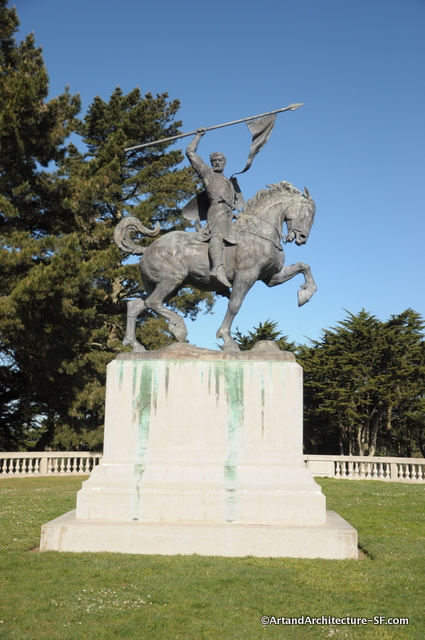This piece is part of the Collection of the Fine Arts Museum. It sits on the lawn in front of the Palace of the Legion of Honor.
Rodrigo Díaz de Vivar (1043 – July 10, 1099), known as El Cid Campeador (“The lord-master of military arts”), was a Castilian nobleman, military leader, and diplomat. Exiled from the court of the Spanish Emperor Alfonso VI of León and Castile, El Cid went on to command a Moorish force consisting of Muladis, Berbers, Arabs and Malians, under Yusuf al-Mu’taman ibn Hud, Moorish king of the northeast Al-Andalus city of Zaragoza, and his successor, Al-Mustain II.
The name El Cid comes from the article el (which means “the” in both Spanish and Arabic), and the dialectal Arabic word سيد sîdi or sayyid, which means “Lord” or “The Master”. The title Campeador means “champion” or “challenger” in Spanish.
Anna Hyatt Huntington, (b. 1876 Cambridge, MA – d. Redding, CT 1973) became one of the best-known and most prolific sculptors of the 20th century. Her father, a paleontologist, interested her in animals. She began to make sculptures of animals that she observed on farms and at the New York City Zoo. She trained as a sculptor, first in Boston, then at the Art Students League in New York, and was taught by Hermon Atkins MacNeil and George Barnard. She also worked for the sculptor Gutzon Borglum.
In the early 1900s, she shared an apartment with the figure sculptor Abastenia St. Leger Eberle. They collaborated on sculptures; Anna Hyatt made the animal figures and Abastenia the human figures. She also studied and worked in France and Italy. One of her earliest public works was the equestrian statue of Joan of Arc, exhibited at the Salon of 1910 in Paris. Several replicas were made, and the statue won Anna the Legion of Honor from the French government. In 1927, she made her first sculpture of ‘El Cid Campeador’ for the city of Seville, Spain.
In 1923, she married the wealthy philanthropist/poet/Spanish scholar Archer M. Huntington (Archer was the adopted son of Collis P. Huntington, the railroad magnate). The couple later (1929) bought 10,000 acres of land near the Atlantic Ocean in South Carolina, named it Brookgreen Gardens and made it a showplace for Anna’s work and for the work of dozens of American figurative sculptors. It was also a sanctuary for plant and animal life of the region. The couple gave the estate, with an endowment, to the state of South Carolina in 1935. It is still a major tourist attraction.


I am not sure what such a statue has to do with SF, but then it doesn’t have to have a connection, it can stand alone! Thanx again for a great commentary and a fine history lesson. I have learned a lot from you!
I like the history of this artist too! What an interesting life.
I imagine it didn’t hurt to have a rich husband to pursue her art! This is such a gorgeous statue.
Really interesting post! I’m in the SF area this week, so busy taking pictures… it’s so photogenic up here!
[…] on trial by the pro-English Bishop of Beauvais, and burned at the stake when she was 19 years old. Anna Huntington has been on this site before. This piece was one of her earliest public works, exhibited at the Salon of 1910 in Paris. […]